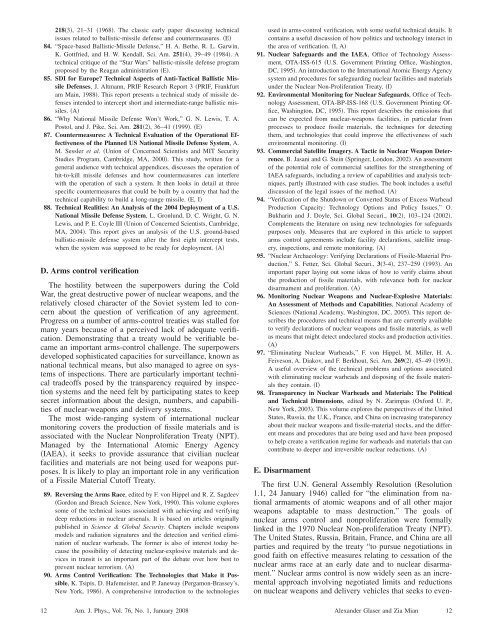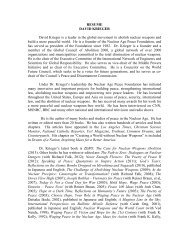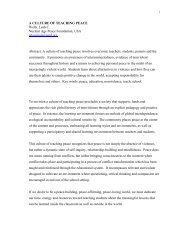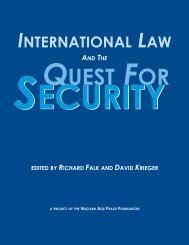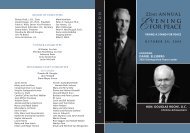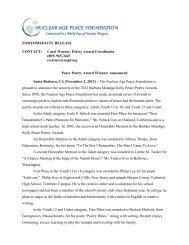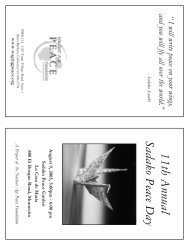Resource Letter PSNAC-1: Physics and society: Nuclear arms control
Resource Letter PSNAC-1: Physics and society: Nuclear arms control
Resource Letter PSNAC-1: Physics and society: Nuclear arms control
You also want an ePaper? Increase the reach of your titles
YUMPU automatically turns print PDFs into web optimized ePapers that Google loves.
2183, 21–31 1968. The classic early paper discussing technical<br />
issues related to ballistic-missile defense <strong>and</strong> countermeasures. E<br />
84. “Space-based Ballistic-Missile Defense,” H. A. Bethe, R. L. Garwin,<br />
K. Gottfried, <strong>and</strong> H. W. Kendall, Sci. Am. 2514, 39–49 1984. A<br />
technical critique of the “Star Wars” ballistic-missile defense program<br />
proposed by the Reagan administration E.<br />
85. SDI for Europe? Technical Aspects of Anti-Tactical Ballistic Missile<br />
Defenses, J. Altmann, PRIF Research Report 3 PRIF, Frankfurt<br />
am Main, 1988. This report presents a technical study of missile defenses<br />
intended to intercept short <strong>and</strong> intermediate-range ballistic missiles.<br />
A<br />
86. “Why National Missile Defense Won’t Work,” G. N. Lewis, T. A.<br />
Postol, <strong>and</strong> J. Pike, Sci. Am. 2812, 36–41 1999. E<br />
87. Countermeasures: A Technical Evaluation of the Operational Effectiveness<br />
of the Planned US National Missile Defense System, A.<br />
M. Sessler et al. Union of Concerned Scientists <strong>and</strong> MIT Security<br />
Studies Program, Cambridge, MA, 2000. This study, written for a<br />
general audience with technical appendices, discusses the operation of<br />
hit-to-kill missile defenses <strong>and</strong> how countermeasures can interfere<br />
with the operation of such a system. It then looks in detail at three<br />
specific countermeasures that could be built by a country that had the<br />
technical capability to build a long-range missile. E, I<br />
88. Technical Realities: An Analysis of the 2004 Deployment of a U.S.<br />
National Missile Defense System, L. Gronlund, D. C. Wright, G. N.<br />
Lewis, <strong>and</strong> P. E. Coyle III Union of Concerned Scientists, Cambridge,<br />
MA, 2004. This report gives an analysis of the U.S. ground-based<br />
ballistic-missile defense system after the first eight intercept tests,<br />
when the system was supposed to be ready for deployment. A<br />
D. Arms <strong>control</strong> verification<br />
The hostility between the superpowers during the Cold<br />
War, the great destructive power of nuclear weapons, <strong>and</strong> the<br />
relatively closed character of the Soviet system led to concern<br />
about the question of verification of any agreement.<br />
Progress on a number of <strong>arms</strong>-<strong>control</strong> treaties was stalled for<br />
many years because of a perceived lack of adequate verification.<br />
Demonstrating that a treaty would be verifiable became<br />
an important <strong>arms</strong>-<strong>control</strong> challenge. The superpowers<br />
developed sophisticated capacities for surveillance, known as<br />
national technical means, but also managed to agree on systems<br />
of inspections. There are particularly important technical<br />
tradeoffs posed by the transparency required by inspection<br />
systems <strong>and</strong> the need felt by participating states to keep<br />
secret information about the design, numbers, <strong>and</strong> capabilities<br />
of nuclear-weapons <strong>and</strong> delivery systems.<br />
The most wide-ranging system of international nuclear<br />
monitoring covers the production of fissile materials <strong>and</strong> is<br />
associated with the <strong>Nuclear</strong> Nonproliferation Treaty NPT.<br />
Managed by the International Atomic Energy Agency<br />
IAEA, it seeks to provide assurance that civilian nuclear<br />
facilities <strong>and</strong> materials are not being used for weapons purposes.<br />
It is likely to play an important role in any verification<br />
of a Fissile Material Cutoff Treaty.<br />
89. Reversing the Arms Race, edited by F. von Hippel <strong>and</strong> R. Z. Sagdeev<br />
Gordon <strong>and</strong> Breach Science, New York, 1990. This volume explores<br />
some of the technical issues associated with achieving <strong>and</strong> verifying<br />
deep reductions in nuclear arsenals. It is based on articles originally<br />
published in Science & Global Security. Chapters include weapons<br />
models <strong>and</strong> radiation signatures <strong>and</strong> the detection <strong>and</strong> verified elimination<br />
of nuclear warheads. The former is also of interest today because<br />
the possibility of detecting nuclear-explosive materials <strong>and</strong> devices<br />
in transit is an important part of the debate over how best to<br />
prevent nuclear terrorism. A<br />
90. Arms Control Verification: The Technologies that Make it Possible,<br />
K. Tsipis, D. Hafemeister, <strong>and</strong> P. Janeway Pergamon-Brassey’s,<br />
New York, 1986. A comprehensive introduction to the technologies<br />
used in <strong>arms</strong>-<strong>control</strong> verification, with some useful technical details. It<br />
contains a useful discussion of how politics <strong>and</strong> technology interact in<br />
the area of verification. I, A<br />
91. <strong>Nuclear</strong> Safeguards <strong>and</strong> the IAEA, Office of Technology Assessment,<br />
OTA-ISS-615 U.S. Government Printing Office, Washington,<br />
DC, 1995. An introduction to the International Atomic Energy Agency<br />
system <strong>and</strong> procedures for safeguarding nuclear facilities <strong>and</strong> materials<br />
under the <strong>Nuclear</strong> Non-Proliferation Treaty. I<br />
92. Environmental Monitoring for <strong>Nuclear</strong> Safeguards, Office of Technology<br />
Assessment, OTA-BP-ISS-168 U.S. Government Printing Office,<br />
Washington, DC, 1995. This report describes the emissions that<br />
can be expected from nuclear-weapons facilities, in particular from<br />
processes to produce fissile materials, the techniques for detecting<br />
them, <strong>and</strong> technologies that could improve the effectiveness of such<br />
environmental monitoring. I<br />
93. Commercial Satellite Imagery. A Tactic in <strong>Nuclear</strong> Weapon Deterrence,<br />
B. Jasani <strong>and</strong> G. Stein Springer, London, 2002. An assessment<br />
of the potential role of commercial satellites for the strengthening of<br />
IAEA safeguards, including a review of capabilities <strong>and</strong> analysis techniques,<br />
partly illustrated with case studies. The book includes a useful<br />
discussion of the legal issues of the method. A<br />
94. “Verification of the Shutdown or Converted Status of Excess Warhead<br />
Production Capacity: Technology Options <strong>and</strong> Policy Issues,” O.<br />
Bukharin <strong>and</strong> J. Doyle, Sci. Global Securi., 102, 103–124 2002.<br />
Complements the literature on using new technologies for safeguards<br />
purposes only. Measures that are explored in this article to support<br />
<strong>arms</strong> <strong>control</strong> agreements include facility declarations, satellite imagery,<br />
inspections, <strong>and</strong> remote monitoring. A<br />
95. “<strong>Nuclear</strong> Archaeology: Verifying Declarations of Fissile-Material Production,”<br />
S. Fetter, Sci. Global Securi., 33-4, 237–259 1993. An<br />
important paper laying out some ideas of how to verify claims about<br />
the production of fissile materials, with relevance both for nuclear<br />
disarmament <strong>and</strong> proliferation. A<br />
96. Monitoring <strong>Nuclear</strong> Weapons <strong>and</strong> <strong>Nuclear</strong>-Explosive Materials:<br />
An Assessment of Methods <strong>and</strong> Capabilities, National Academy of<br />
Sciences National Academy, Washington, DC, 2005. This report describes<br />
the procedures <strong>and</strong> technical means that are currently available<br />
to verify declarations of nuclear weapons <strong>and</strong> fissile materials, as well<br />
as means that might detect undeclared stocks <strong>and</strong> production activities.<br />
A<br />
97. “Eliminating <strong>Nuclear</strong> Warheads,” F. von Hippel, M. Miller, H. A.<br />
Feiveson, A. Diakov, <strong>and</strong> F. Berkhout, Sci. Am. 2692, 45–491993.<br />
A useful overview of the technical problems <strong>and</strong> options associated<br />
with eliminating nuclear warheads <strong>and</strong> disposing of the fissile materials<br />
they contain. I<br />
98. Transparency in <strong>Nuclear</strong> Warheads <strong>and</strong> Materials: The Political<br />
<strong>and</strong> Technical Dimensions, edited by N. Zarimpas Oxford U. P.,<br />
New York, 2003. This volume explores the perspectives of the United<br />
States, Russia, the U.K., France, <strong>and</strong> China on increasing transparency<br />
about their nuclear weapons <strong>and</strong> fissile-material stocks, <strong>and</strong> the different<br />
means <strong>and</strong> procedures that are being used <strong>and</strong> have been proposed<br />
to help create a verification regime for warheads <strong>and</strong> materials that can<br />
contribute to deeper <strong>and</strong> irreversible nuclear reductions. A<br />
E. Disarmament<br />
The first U.N. General Assembly Resolution Resolution<br />
1.1, 24 January 1946 called for “the elimination from national<br />
armaments of atomic weapons <strong>and</strong> of all other major<br />
weapons adaptable to mass destruction.” The goals of<br />
nuclear <strong>arms</strong> <strong>control</strong> <strong>and</strong> nonproliferation were formally<br />
linked in the 1970 <strong>Nuclear</strong> Non-proliferation Treaty NPT.<br />
The United States, Russia, Britain, France, <strong>and</strong> China are all<br />
parties <strong>and</strong> required by the treaty “to pursue negotiations in<br />
good faith on effective measures relating to cessation of the<br />
nuclear <strong>arms</strong> race at an early date <strong>and</strong> to nuclear disarmament.”<br />
<strong>Nuclear</strong> <strong>arms</strong> <strong>control</strong> is now widely seen as an incremental<br />
approach involving negotiated limits <strong>and</strong> reductions<br />
on nuclear weapons <strong>and</strong> delivery vehicles that seeks to even-<br />
12 Am. J. Phys., Vol. 76, No. 1, January 2008<br />
Alex<strong>and</strong>er Glaser <strong>and</strong> Zia Mian 12


